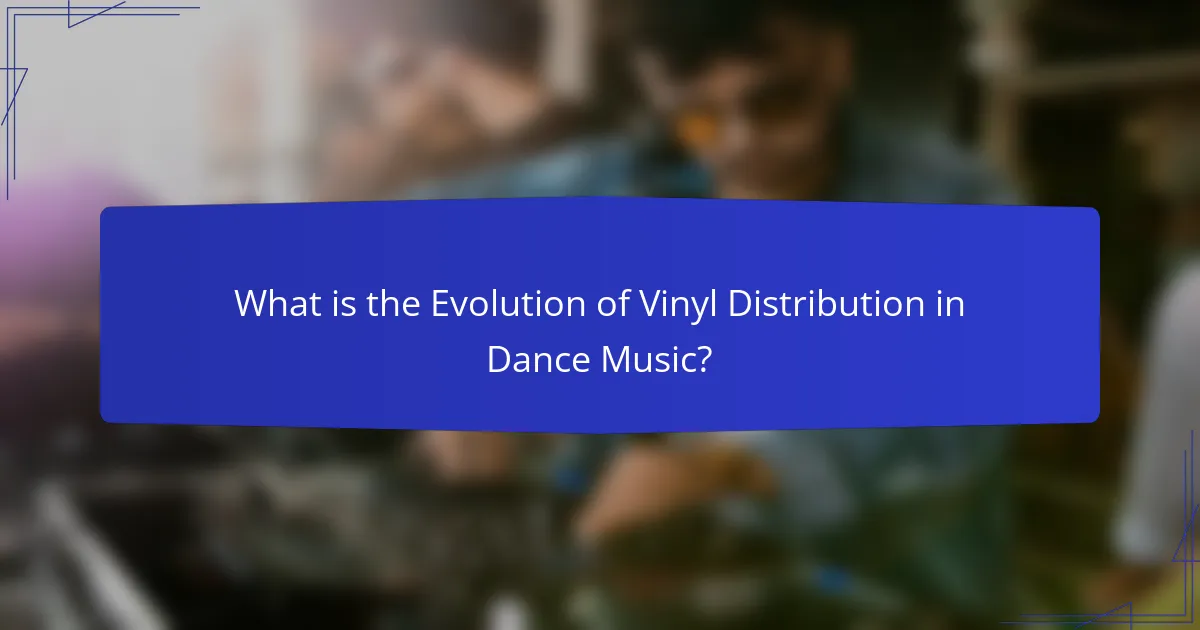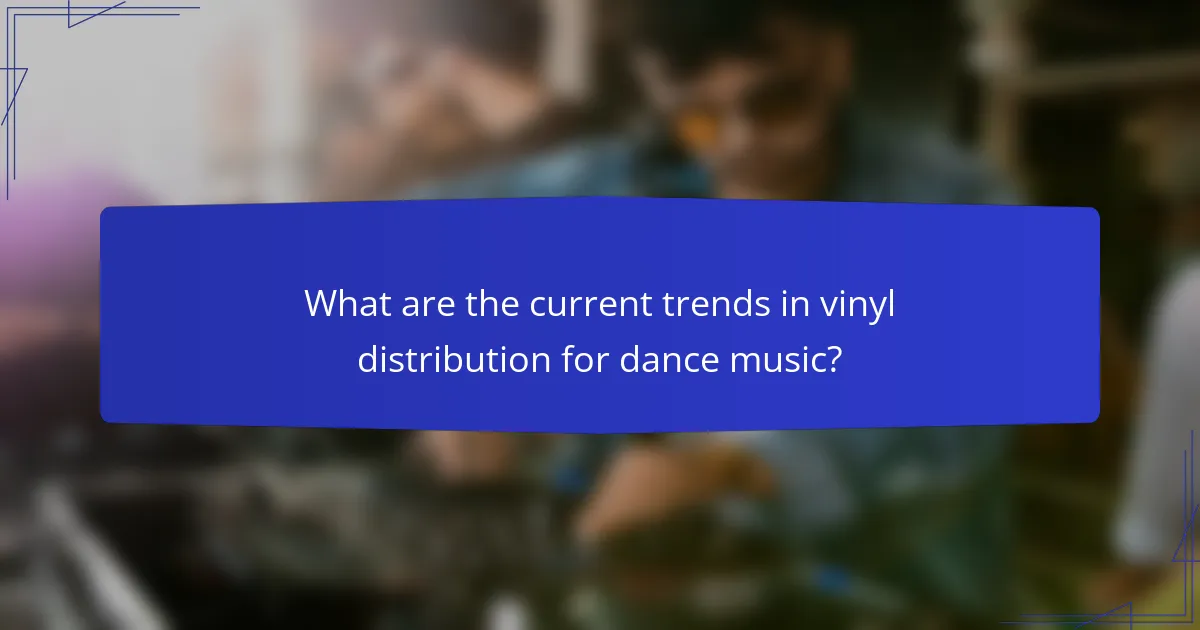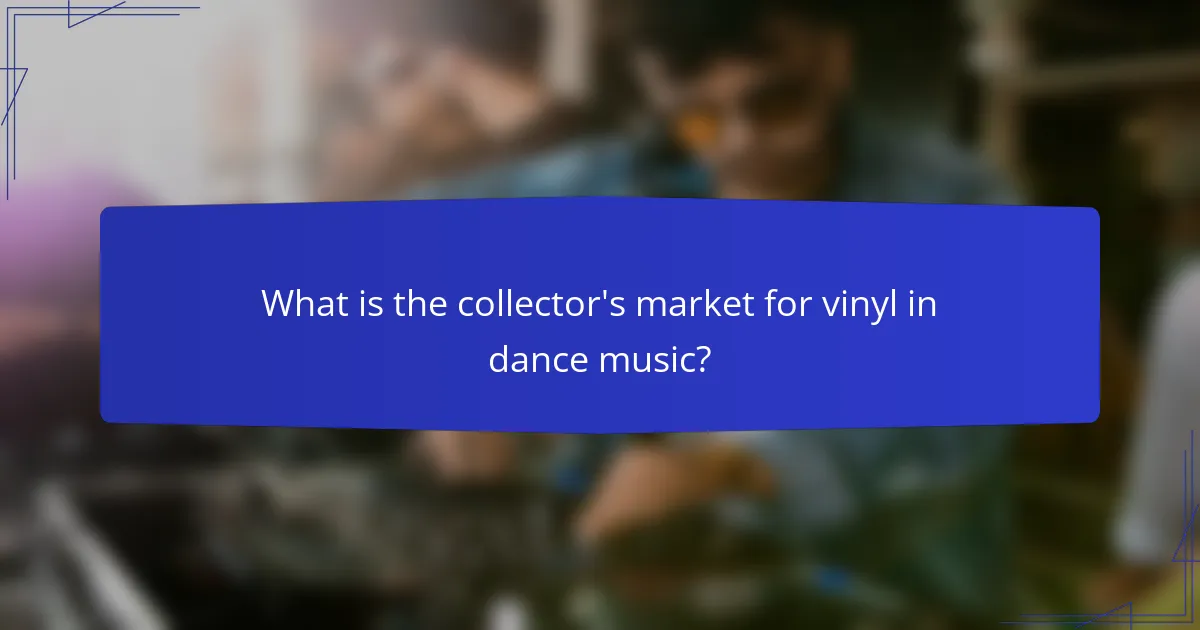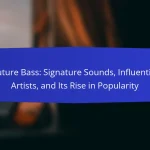The article examines the evolution of vinyl distribution in dance music, highlighting key trends, formats, and the collector’s market. Initially dominated by 12-inch vinyl singles in the disco era, the medium remained vital through the rise of electronic dance music in the 1990s. The transition to digital formats in the 2000s shifted the landscape, yet a resurgence of vinyl in the 2010s has reignited interest among collectors and enthusiasts. Current trends include direct-to-consumer sales, limited edition releases, and eco-friendly pressing options, reflecting a strong community engagement and the cultural significance of vinyl in dance music. The collector’s market has grown, driven by the demand for rare pressings and unique artwork, with notable labels contributing to this niche segment.

What is the Evolution of Vinyl Distribution in Dance Music?
The evolution of vinyl distribution in dance music has undergone significant changes since the genre’s inception. Initially, vinyl records were the primary medium for distributing dance music. In the late 1970s and early 1980s, disco music popularized 12-inch vinyl singles, allowing DJs to play longer tracks. This format became a standard in dance music distribution.
With the rise of electronic dance music in the 1990s, vinyl remained essential for DJs. Labels focused on producing high-quality pressings to meet demand. However, the advent of digital formats in the 2000s began to shift the landscape. Digital downloads and streaming services started to dominate music distribution.
Despite this shift, vinyl experienced a resurgence in the 2010s. Many collectors and enthusiasts sought physical records for their unique sound and artwork. This revival led to a renewed interest in vinyl distribution within the dance music community.
Today, independent labels and artists often release limited edition vinyl to cater to collectors. Online platforms have made it easier to distribute vinyl globally. The current trend emphasizes both nostalgia and quality, with vinyl sales in the U.S. surpassing CD sales for the first time in decades in 2020. This evolution reflects the enduring appeal of vinyl in dance music culture.
How has vinyl distribution changed over the decades?
Vinyl distribution has evolved significantly over the decades. In the 1950s and 1960s, vinyl records were primarily distributed through physical retail stores. Major record labels controlled the supply chain, focusing on mass production for popular music. By the 1970s, independent labels emerged, diversifying distribution channels. The 1980s saw the introduction of cassette tapes, which affected vinyl sales. However, vinyl maintained a loyal following among collectors and audiophiles.
In the 1990s, digital formats began to dominate, leading to a decline in vinyl distribution. Despite this, a resurgence occurred in the 2000s, driven by a renewed interest in analog sound quality. Online retailers and platforms like Discogs transformed how collectors accessed vinyl. Today, vinyl is distributed through a mix of independent record shops, online marketplaces, and major retailers. The collector’s market has expanded, with limited editions and unique pressings gaining popularity. This evolution reflects changing consumer preferences and technological advancements in music distribution.
What were the key milestones in vinyl distribution history?
The key milestones in vinyl distribution history include the introduction of the 78 RPM record in the late 19th century. This format allowed for the mass production of music. In the 1940s, the 33 1/3 RPM long-playing record was developed, enabling longer playback times. The 45 RPM single emerged in the 1940s, becoming popular for hit songs. The 1950s saw the rise of independent record labels, expanding distribution channels. The introduction of stereo records in the 1960s enhanced audio quality for listeners. The decline of vinyl began in the 1980s with the advent of cassette tapes and CDs. However, the resurgence of vinyl started in the 2000s, driven by collectors and audiophiles seeking analog sound. These milestones illustrate the evolution of vinyl distribution over time.
How did technological advancements influence vinyl distribution?
Technological advancements significantly influenced vinyl distribution by streamlining production and enhancing accessibility. The introduction of digital recording technology improved sound quality and reduced production costs. This allowed for faster replication of vinyl records. Automation in manufacturing processes increased efficiency in pressing vinyl. Online platforms emerged, enabling direct-to-consumer sales and expanding the market reach. Additionally, digital distribution methods facilitated the promotion of vinyl releases through social media and streaming services. These advancements contributed to the resurgence of vinyl in the music industry, with sales reaching over 27 million units in the U.S. in 2020, the highest since the 1980s.
What role does vinyl play in the dance music scene today?
Vinyl plays a significant role in the dance music scene today as a medium for both DJs and collectors. It serves as a tangible format that enhances the experience of music consumption. Many DJs prefer vinyl for its authentic sound quality and tactile nature. This preference is evident in live performances, where vinyl records are often used to create a unique atmosphere. The resurgence of vinyl sales, which reached over 41 million units in 2022 in the U.S. alone, highlights its continued relevance. Collectors value limited edition pressings and unique artwork, contributing to a thriving market. Vinyl also fosters a sense of community among enthusiasts who share a passion for the format. Overall, vinyl remains a vital component of the dance music culture, bridging the gap between past and present.
Why do artists and DJs prefer vinyl over digital formats?
Artists and DJs prefer vinyl over digital formats due to the unique sound quality and tactile experience it offers. Vinyl records provide a warm, rich sound that many believe digital formats cannot replicate. The physical act of handling records creates a deeper connection to the music. Additionally, vinyl allows for larger artwork and packaging, enhancing the overall aesthetic. Many artists appreciate the collectible nature of vinyl, which can increase in value over time. According to a 2020 report by the Recording Industry Association of America, vinyl sales reached a 30-year high, indicating a strong preference among consumers. This trend reflects a broader cultural movement valuing analog formats.
How does vinyl contribute to the authenticity of dance music?
Vinyl contributes to the authenticity of dance music by providing a tangible medium that enhances the listening experience. The physical nature of vinyl records allows for unique sound characteristics, including warmth and depth. This quality is often preferred by audiophiles and DJs alike. Vinyl also fosters a connection between the artist and the listener. Collectors value the artwork and packaging, which adds to the overall experience. Historically, many iconic dance tracks were originally released on vinyl. This legacy reinforces the perception of vinyl as a genuine format for dance music. The act of DJing with vinyl is seen as a skillful art form that emphasizes authenticity. Many dance music genres, such as house and techno, have roots in vinyl culture. This historical context solidifies vinyl’s role in the authenticity of the genre.

What are the current trends in vinyl distribution for dance music?
Current trends in vinyl distribution for dance music include a rise in direct-to-consumer sales. Many artists and labels are bypassing traditional retail channels. This shift allows for better profit margins and direct engagement with fans. Limited edition releases are increasingly popular. These often feature unique artwork or colored vinyl, appealing to collectors. Additionally, online platforms for vinyl sales are expanding. Websites like Bandcamp and Discogs facilitate niche market access. There is also a growing interest in eco-friendly pressing options. Sustainable practices are becoming a priority for many labels. Overall, the vinyl market for dance music is experiencing a revival driven by community engagement and collector culture.
How are consumer preferences shaping vinyl distribution trends?
Consumer preferences are significantly influencing vinyl distribution trends. Increased demand for vinyl records has led to a resurgence in both production and sales. According to the Recording Industry Association of America, vinyl sales reached 41 million units in 2020, marking a 29% increase from the previous year. This growth reflects a shift towards physical formats among music enthusiasts who value the tactile experience of vinyl.
Collectors are now prioritizing limited editions and unique pressings. This trend has prompted labels to produce more exclusive releases to cater to this market. Additionally, the rise of online platforms has made it easier for consumers to access diverse vinyl selections.
As a result, traditional distribution channels are adapting to include direct-to-consumer sales. Record stores are also evolving, offering curated selections that align with consumer tastes. Overall, consumer preferences are driving innovation in vinyl distribution, emphasizing quality and uniqueness.
What factors are driving the resurgence of vinyl popularity?
The resurgence of vinyl popularity is driven by nostalgia, sound quality, and collector culture. Many consumers have a nostalgic connection to vinyl records from their past. This emotional appeal enhances the desire to own physical music. Additionally, vinyl offers a unique sound quality that many audiophiles prefer over digital formats. The warm tones and larger audio spectrum of vinyl provide an immersive listening experience. Furthermore, the rise of collector culture has created a market for limited editions and unique pressings. According to the Recording Industry Association of America, vinyl sales reached a 30-year high in 2020, indicating a significant increase in demand. The combination of these factors contributes to the ongoing popularity of vinyl records in today’s music landscape.
How do social media and online communities impact vinyl sales?
Social media and online communities significantly boost vinyl sales. They create platforms for artists to share music and engage with fans. This interaction fosters a sense of community around vinyl culture. Online discussions generate excitement and anticipation for new releases. Social media also allows for targeted marketing to niche audiences. For instance, platforms like Instagram showcase visually appealing vinyl collections. This encourages users to purchase records for both listening and display. Additionally, online marketplaces facilitate easy access to vinyl, expanding the consumer base. A report from the Recording Industry Association of America (RIAA) shows that vinyl sales reached 41 million units in 2020, largely driven by social media influence.
What are the emerging formats of vinyl in dance music distribution?
Emerging formats of vinyl in dance music distribution include colored vinyl, picture discs, and 12-inch singles. Colored vinyl offers aesthetic appeal and uniqueness, attracting collectors. Picture discs feature printed artwork on the vinyl surface, enhancing visual presentation. 12-inch singles provide higher audio quality and longer playtime, making them popular among DJs. These formats cater to both audiophiles and collectors, reflecting trends in the market. Recent reports indicate a resurgence in vinyl sales, particularly in niche genres like dance music. This trend underscores the evolving preferences of consumers for unique and collectible formats.
What are the differences between standard and special edition vinyl?
Standard edition vinyl typically features the album’s core tracks in a traditional format. Special edition vinyl often includes additional content like bonus tracks, remixes, or exclusive artwork. Standard editions are mass-produced, while special editions are usually limited runs. Special editions may also use unique colors or packaging to enhance collectibility. The production quality of special editions can be higher, often featuring heavier vinyl for better sound quality. Collectors often seek special editions for their rarity and unique attributes. Standard editions are more accessible and widely available in retail stores. Special editions cater to dedicated fans and collectors, making them more desirable in niche markets.
How do colored and picture vinyl affect collectibility?
Colored and picture vinyl significantly enhance collectibility. Collectors often seek unique variants, making these editions more desirable. Limited pressings of colored vinyl can drive up demand and value. Picture discs, featuring artwork, attract visual appeal and niche collectors. Historical data shows that certain colored vinyl editions appreciate in value over time. For instance, some limited releases have sold for several times their original retail price. The uniqueness of these formats often creates a sense of exclusivity among collectors. Consequently, colored and picture vinyl are frequently viewed as investment pieces in the music market.

What is the collector’s market for vinyl in dance music?
The collector’s market for vinyl in dance music is a niche segment focused on purchasing and selling vinyl records within the dance genre. This market has seen a resurgence due to the growing interest in analog formats. Collectors often seek rare pressings, limited editions, and unique artwork. Notable labels like Warp and Ninja Tune have contributed to this trend by releasing exclusive vinyl. Prices for sought-after records can reach hundreds to thousands of dollars. Events like Record Store Day further stimulate interest in vinyl among collectors. According to a 2022 report by the Recording Industry Association of America, vinyl sales in the U.S. surpassed CD sales for the first time since the 1980s. This data highlights the strong demand and cultural significance of vinyl in dance music.
What makes certain vinyl records highly sought after by collectors?
Certain vinyl records are highly sought after by collectors due to their rarity, historical significance, and unique attributes. Rarity often stems from limited pressings, such as promotional releases or records that were quickly withdrawn. Historical significance can be linked to influential artists or landmark albums that shaped music genres. Unique attributes include special editions, colored vinyl, or unique artwork that differentiate them from standard releases. For instance, the Beatles’ “Butcher Cover” is valued for its controversial artwork and limited availability. Collectors often seek records that not only sound exceptional but also tell a story or represent a specific moment in music history.
How do rarity and condition influence vinyl value?
Rarity and condition significantly influence vinyl value. Rarity refers to how uncommon a specific vinyl record is in the market. Limited pressings or exclusive releases tend to be more valuable. Condition describes the physical state of the vinyl and its packaging. Records in mint condition attract higher prices. According to Discogs, a marketplace for music collectors, rare records can sell for thousands of dollars. Conversely, records in poor condition can be worth substantially less. The combination of rarity and condition creates a strong determinant for collectors and investors.
What are the most valuable dance music vinyl records ever sold?
The most valuable dance music vinyl records ever sold include several notable items. One of the highest recorded sales is “The Beatles – The White Album,” which sold for $790,000 in 2015. Another significant sale is “Daft Punk – Homework,” a rare edition that fetched $100,000 at auction. Additionally, “The Black Album” by Prince is valued at around $27,500 due to its limited release. These records are sought after for their rarity and cultural impact. Their high prices reflect the growing collector’s market in dance music vinyl.
How can collectors navigate the vinyl market effectively?
Collectors can navigate the vinyl market effectively by staying informed about trends and valuing condition. Researching current market prices helps collectors make informed purchases. Utilizing online platforms and local record shops ensures access to a wide selection. Joining vinyl communities fosters connections and knowledge sharing among collectors. Understanding the rarity and demand of specific records guides investment decisions. Regularly attending record fairs provides opportunities to discover unique items. Keeping track of releases through labels and artists enhances collection relevance. Finally, maintaining records of purchases aids in tracking value over time.
What tips can help new collectors start their vinyl journey?
Start by researching different genres and artists to identify your preferences. Explore local record stores and online marketplaces for vinyl records. Invest in a quality turntable to enhance your listening experience. Learn about vinyl care to maintain the condition of your records. Join vinyl collector communities for tips and recommendations. Attend record fairs to discover rare finds and connect with other collectors. Set a budget to manage your spending effectively. Document your collection to keep track of your records and their values.
How can one identify authentic versus counterfeit records?
To identify authentic versus counterfeit records, examine several key factors. Authentic records typically feature high-quality packaging and printing. Check for proper label details, including catalog numbers and logos. Genuine records often have a heavier weight and a glossy finish. Inspect the matrix numbers etched into the vinyl, as these are unique identifiers for authentic pressings. Compare the sound quality; authentic records usually have clearer audio without distortion. Research the release history to confirm the existence of the record. Counterfeit records may lack these characteristics and often have discrepancies in design or sound quality.
What resources are available for vinyl collectors in dance music?
Vinyl collectors in dance music have access to various resources. Online marketplaces like Discogs allow users to buy and sell vinyl records. Record stores specializing in dance music often stock both new releases and rare finds. Social media groups and forums provide platforms for collectors to exchange information and trade records. Music festivals frequently feature vendors selling exclusive vinyl editions. Additionally, magazines and blogs dedicated to dance music often review new releases and highlight collectible items. These resources help collectors discover, acquire, and connect with the dance music vinyl community.
What online platforms are best for buying and selling vinyl?
Discogs, eBay, and Bandcamp are the best online platforms for buying and selling vinyl. Discogs is a dedicated marketplace for music collectors, offering extensive cataloging options. eBay provides a broad audience and auction-style listings for vinyl records. Bandcamp allows artists to sell their music directly, including vinyl formats. These platforms have large user bases and facilitate secure transactions. Discogs has over 30 million releases listed, making it a leading resource for collectors. eBay’s global reach enhances visibility for sellers. Bandcamp supports independent artists, promoting unique vinyl releases.
How can collectors connect with other enthusiasts and communities?
Collectors can connect with other enthusiasts and communities through online platforms and local events. Social media groups dedicated to vinyl collecting provide a space for discussion and sharing. Websites such as Discogs allow collectors to buy, sell, and interact with each other. Forums and blogs focused on vinyl music create opportunities for knowledge exchange. Local record stores often host events, fostering community connections. Vinyl fairs and conventions are excellent venues for meeting fellow collectors. Engaging in these activities helps build a network within the collector community.
The main entity of this article is the evolution of vinyl distribution in dance music. The article outlines the historical progression of vinyl distribution from its origins in the late 1970s to its resurgence in the 2010s, highlighting key milestones and technological advancements that have shaped the market. It discusses current trends such as direct-to-consumer sales, the popularity of limited editions, and the impact of social media on vinyl sales. Additionally, the article explores the collector’s market for dance music vinyl, including factors that influence value and tips for navigating the market effectively.


